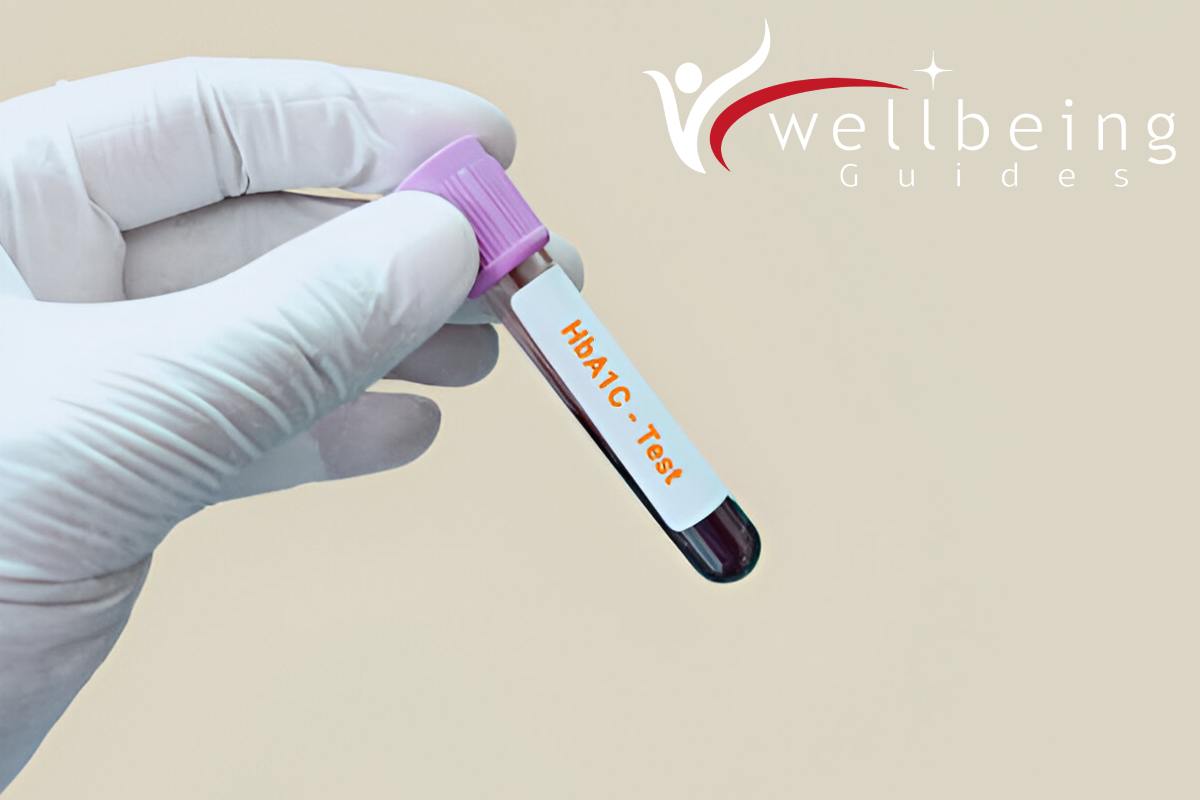What is Normal HbA1c By Age
What is HbA1c Test?
HbA1c test, also known as glycated hemoglobin A1c, is used to measure the blood sugar levels in the body, which aids in diagnosing and managing diabetes mellitus. The HbA1c blood test value (denoted in percentage) indicates the average blood sugar level for the past 2–3 months. The HbA1c test normal range includes values between 4 and 5.7%; less than 6.5% indicates prediabetes, and a HbA1c value of 6.5% or more indicates hyperglycaemia (diabetes mellitus).
The haemoglobin is a protein found in red blood cells, providing a bright red colour to the blood. The haemoglobin consists of two alpha and two beta polypeptide chains with different amino acid sequences. The glycated hemoglobin or glycohemoglobin is formed due to the ketoamine reaction between the blood glucose (sugar molecules) and the N-terminal amino acid of the beta polypeptide chain of haemoglobin, resulting in the attachment of blood sugar molecule to the haemoglobin protein.
Hba1c Test Uses
HbA1c test full form in medical – Glycated hemoglobin or haemoglobin A1c
In general, healthy persons contain glycated haemoglobin; however, in prediabetics or diabetics, the excess amount of unutilised sugar molecules present in the blood (which might occur due to insulin resistance or absence of insulin production) attaches to the haemoglobin, resulting in higher levels of glycosylated haemoglobin. The amount of glycohemoglobin produced is directly proportional to the mean blood glucose during the 8-10-week period prior to the initiation of the HbA1c test, which thereby provides an average of 2-3 months days of blood sugar levels.
The Blood Sugar Test Hba1c Is Used To Screen And Diagnose The Following Conditions:
Diabetes mellitus
Prediabetes
Diabetes mellitus: It is a metabolic disorder characterised by an increase in blood sugar levels or hyperglycemia. Hyperglycemia is caused by decreased insulin secretion, poor glucose utilisation, and increased glucose production, all of which can be related to the underlying cause of diabetes mellitus.
Prediabetes: It is a condition where there will be an increase in blood sugar levels than normal levels; however, it is not high enough to diagnose diabetes.
Importance of HbA1c test
The HbA1c test is incredibly important for several reasons:
Diagnosis and Screening:
Prediabetes detection: It helps identify prediabetes, a condition with higher than normal blood sugar levels but not yet high enough for a diabetes diagnosis. Early detection allows for lifestyle changes to potentially prevent or delay the onset of diabetes.
Diabetes diagnosis: It aids in diagnosing type 2 diabetes by providing a snapshot of average blood sugar control over the past 3 months, offering a more reliable picture than a single finger-prick test.
Monitoring and Treatment:
Risk assessment: A high HbA1c level indicates a greater risk of developing diabetes complications like heart disease, stroke, kidney disease, nerve damage, and vision problems. Early detection and proactive management can help prevent or delay these complications.
Treatment plan evaluation: For people with existing diabetes, the HbA1c test assesses how well their blood sugar levels are being managed under their current treatment plan. This information is crucial for making adjustments to medication, diet, or exercise recommendations.
Additional Benefits:
Motivation: Regularly monitoring HbA1c levels can act as a motivator for people with diabetes to adhere to their treatment plan and maintain healthy habits.
Convenience: Unlike finger-prick tests, which require multiple daily measurements, the HbA1c test only needs to be done every 3–6 months, depending on individual needs.
Overall, the HbA1c test is a valuable tool for managing diabetes and preventing its complications. It provides a comprehensive picture of long-term blood sugar control, allowing for informed treatment decisions and proactive risk management.
While the HbA1c test is highly reliable, certain factors like recent blood transfusions, certain medications, and some blood cell disorders can affect the results. Discussing any potential influencing factors with your primary care physician or doctor is crucial for accurate interpretation. The target HbA1c level may vary slightly depending on individual circumstances.
HbA1c test indication
For screening, diagnosis or managing diabetes, one might opt for an HbA1c test in the following scenarios.
Screening:
Patients over the age of 45
Overweight patients under the age of 45 and having one or more risk factors for prediabetes or type 2 diabetes.
Second test: If the patient is asymptomatic but still has an HbA1c value between 5.7% and 6.4% (prediabetes) or more than that (diabetes), a second test is recommended on a different day.
HbA1c test: Once every 1 to 2 years: In patients who are prediabetic and taking measures to control and lower the risk of diabetes mellitus.
HbA1c test: Once every 3 years: In normal HbA1c patients with age over 45 and having associated risk factors or ever had a history of gestational diabetes
In managing diabetes: In patients with uncontrolled diabetes and are on oral antidiabetic medications, the best time for HbA1c test, as per the American Diabetes Association (ADA) suggestions, is once every three months. In the case of stable and well-controlled patients, the sugar test HbA1c should be performed once in every six months.
Preparation for HbA1c test procedure
The patient needs to inform the diabetologist or endocrinologist about intake of their daily medications.
The patient can have food prior to the test, as the HbA1c test measures the average glucose concentration.
HbA1c test procedure:
The HbA1c test can be done as a point of care or by sending the samples to the laboratory. The phlebotomist might draw 5 ml of blood by puncturing a vein from the arm with a small needle. The collected blood sample will be transferred into an HbA1c blood test vial and sent for further analysis.
Once the sample is collected, with the help of any of the haemoglobin A1c. Measure methods (ion-exchange HPLC, immunoassay, boronate affinity HPLC or enzymatic assays) the glycated haemoglobin value is measured.
HbA1c test range
The glycated hemoglobin (HbA1c) test provides average blood glucose levels for the past two to three months. The following are the HbA1c test report values.
- The hemoglobin A1c normal range is between 4 and 5.6%.
- If the hemoglobin A1c level is between 5.7 to 6.4%, the patient is at risk of hyperglycemia (presence of high blood glucose levels) or prediabetes.
- If the hemoglobin A1c level is 6.5% or higher, it indicates hyperglycemia or diabetes mellitus condition.
Factors that might affect the HbA1c test result
The following conditions can alter (increase or decrease) the reading of HbA1c:
Intake of vitamin C supplementations (depends on the method used for measurement)
Falsely low HbA1c values
- Residing at a high-altitude region
- Pregnancy
- aemorrhage, liver cirrhosis, chronic kidney failure, sickle cell anaemia, haemolytic anaemia, and spherocytosis
- On erythropoietin administration and iron supplementation
Falsely high HbA1c values
- Low iron levels, which might be due to infection-induced anaemia, iron deficiency anaemia or tumour-induced anaemia,
- Presence of thalassemia and vitamin B12 deficiency
- Organ transplantation, hypertriglyceridemia and hyperglycation in some ethnic groups
- Intake of protease inhibitor agents or immunosuppressants
Correlation between Haemoglobin A1c and blood sugar
As per the American Diabetes Association (ADA), the relationship between the haemoglobin A1c and estimated average blood sugar can be described by the following formula. Which provides average blood glucose levels (estimated) for the past 70 to 90 days.
Difference between blood glucose test and HbA1c
HbA1c vs blood sugar
Both tests are used to measure blood glucose (sugar) levels; however, the following are the differences between them.
| Elements | Blood glucose test | HbA1c test |
| Measurement | Measures milligrams of glucose per decilitre of blood. | Measures the percentage of glucose bound to red blood cells (haemoglobin). |
| Fasting | Required fasting (overnight) to obtain fasting plasma glucose levels. | Not required fasting as it provides average glucose levels for the last 2-3 months. |
| Units of measurement | mg/dL | Percentage (%) |
| Use of Glucometer | Glucometer can be used to check for blood glucose. | Glucometer can’t provide HbA1c value. |
| Indicates | Blood glucose levels on the day of the test or 24 hours. | Average blood glucose levels for last the 2-3 months from the date of test. |



